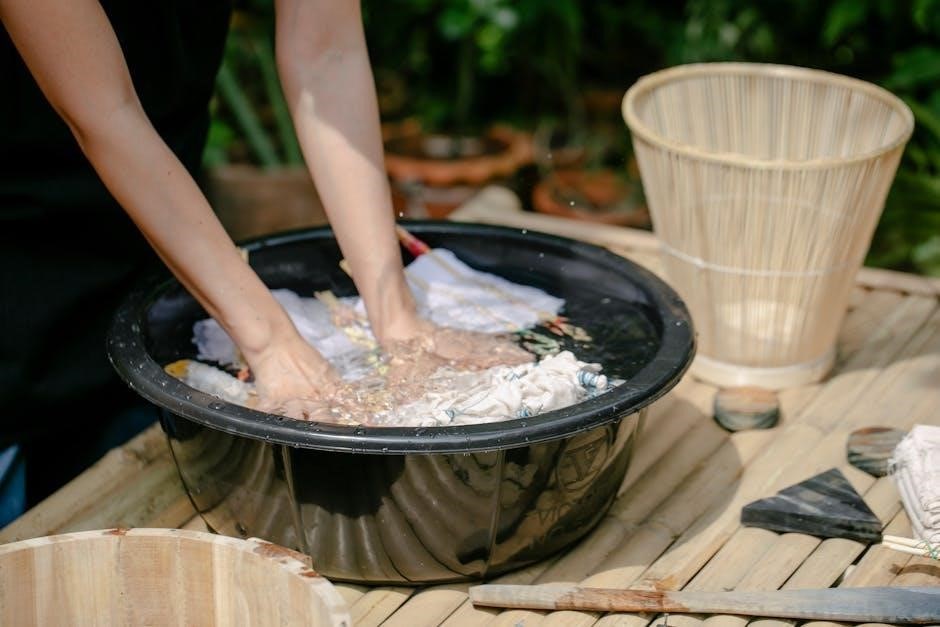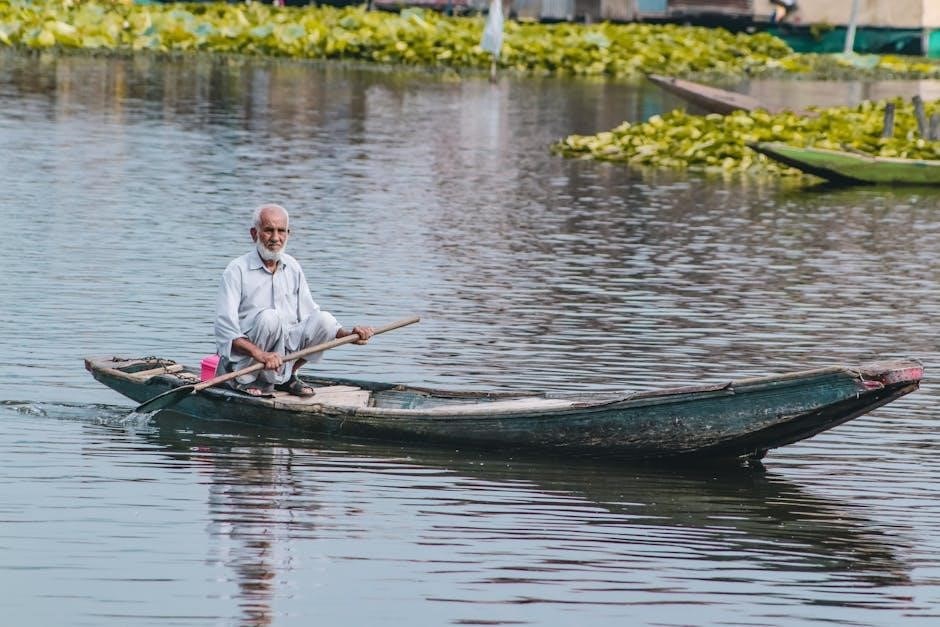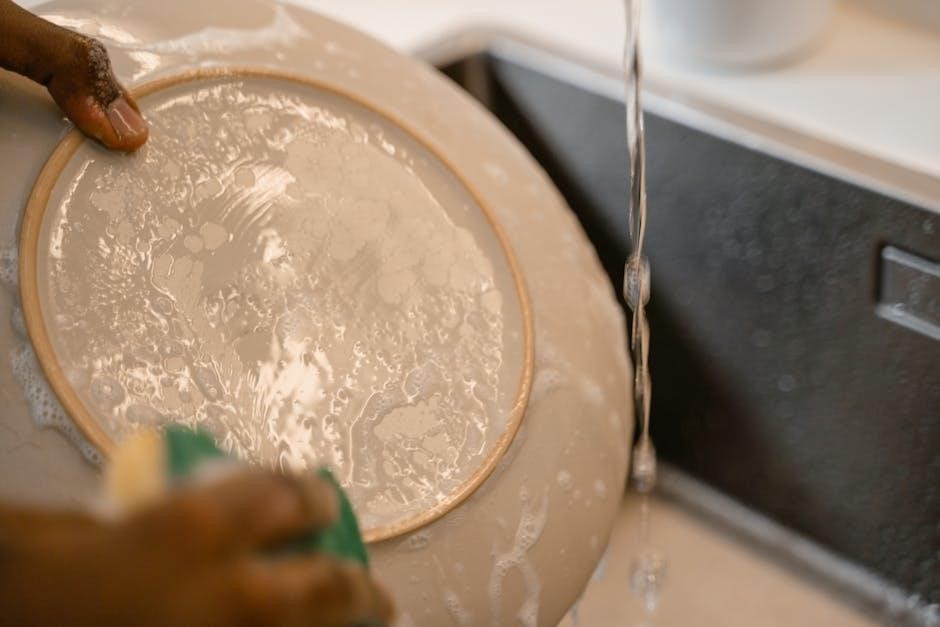
Welcome to the Truma Water Heater Manual. This guide provides comprehensive instructions for installing, operating, and maintaining your Truma water heater. Ensure optimal performance and safety by following the detailed steps and recommendations outlined in this manual.
1.1 Overview of Truma Water Heaters
Truma water heaters are renowned for their reliability, efficiency, and innovative design, catering to various needs in caravans, motorhomes, and boats. Available in models such as the Ultrastore and Rapid XL, these heaters offer consistent hot water supply with minimal energy consumption. The CP Plus control panel enhances user experience, allowing easy temperature adjustments and mode switching. Designed for safety, Truma water heaters feature built-in thermal cut-offs and anti-scald protection. Specialized models, like the DVGW-tested boat water heater, ensure compliance with marine safety standards. Whether electric or gas-powered, Truma water heaters deliver exceptional performance, making them a top choice for outdoor enthusiasts seeking comfort and convenience on the go.
1.2 Importance of Reading the Manual
Reading the Truma water heater manual is essential for ensuring safe and efficient operation. It provides critical information on installation, maintenance, and troubleshooting, helping users avoid potential hazards. The manual details error codes, safety precautions, and proper usage guidelines to prevent accidents like scalding or fire. Understanding the control panel functions, such as the CP Plus, is vital for optimizing performance. Additionally, it outlines specific considerations for boat installations, ensuring compliance with marine safety standards. By following the manual, users can extend the lifespan of their water heater and ensure reliable hot water supply. Neglecting the manual may lead to improper usage, void warranties, or pose serious safety risks. Always refer to the manual before performing any maintenance or repairs.

Technical Specifications
Truma water heaters feature models like Ultrastore Rapid XL with 10-liter capacity and 850W heating elements. They operate at 230V, with gas/electric options, ensuring efficient hot water supply.
2.1 Models and Variants
Truma offers a range of water heater models, including the popular Ultrastore and Carver Cascade series. The Ultrastore Rapid XL is a high-capacity model designed for continuous hot water supply, while the Carver Cascade 2 features a compact design suitable for smaller spaces. Both models are available in gas/electric variants, providing flexibility for different energy sources. The Ultrastore models are known for their 10-liter capacity and 850W heating elements, operating at 230V for efficient performance. Additionally, Truma offers boat-specific water heaters with DVGW approval, ensuring safety and reliability for marine installations. Each variant is tailored to meet specific needs, whether for caravans, motorhomes, or boats, offering a versatile solution for hot water requirements.
2.2 Key Features and Benefits
The Truma water heaters are designed with cutting-edge technology to provide reliable and efficient hot water solutions. Key features include high-capacity tanks, rapid heating elements, and quiet operation. The Ultrastore Rapid XL model offers a high flow rate, while the Carver Cascade 2 is known for its compact design. Both models are equipped with 850W heating elements for fast water heating. The digital CP Plus control panel allows users to easily switch between modes and monitor temperatures. These heaters are also energy-efficient, reducing power consumption during standby. Safety is prioritized with features like DVGW approval for boat installations and automatic shut-off to prevent overheating. These benefits ensure a consistent and safe hot water supply, making Truma heaters ideal for caravans, motorhomes, and boats.
Installation Instructions
Install the Truma water heater by preparing the site, mounting the unit securely, and connecting water and electrical systems. Ensure proper ventilation and follow all safety guidelines for a safe setup.
3.1 Pre-Installation Checks
Before installing your Truma water heater, ensure the site is prepared and meets all safety requirements. Verify the model is suitable for your application and consult the manual for specific instructions. Check the electrical supply matches the heater’s specifications and ensure water connections are compatible. Inspect the area for flammable materials and ensure proper ventilation. Review the control panel settings, such as the CP Plus, and familiarize yourself with the installation diagram. Ensure all necessary parts and accessories are included in the package. For boat installations, confirm DVGW approval and follow marine-specific guidelines. Always adhere to local regulations and safety standards to avoid hazards. Proper preparation ensures a smooth and safe installation process.
3.2 Step-by-Step Installation Guide
Begin by preparing the installation site, ensuring it is level, well-ventilated, and free from flammable materials. Mount the water heater securely, using the provided brackets, and ensure it is accessible for future maintenance. Connect the electrical supply according to the specifications in the manual, ensuring compatibility with your system. For gas models, install the gas line and test for leaks. Connect the water inlet and outlet hoses, ensuring they are compatible with the heater’s ports. Activate the CP Plus control panel, following the startup sequence outlined in the instructions. Test the system by running hot water through the taps to ensure proper function. Finally, double-check all connections and settings to ensure safe and efficient operation. Always follow the manufacturer’s guidelines and local regulations during installation.
3.3 Special Considerations for Boat Installation
Ensure the installation site is level, well-ventilated, and free from flammable materials. Securely mount the water heater using the provided brackets, ensuring accessibility for future maintenance. Connect the electrical supply according to the manual’s specifications, verifying compatibility with your system. For gas models, install the gas line and test for leaks using a soap solution. Connect the water inlet and outlet hoses, ensuring they are compatible with the heater’s ports. Activate the CP Plus control panel by following the startup sequence outlined in the instructions. Test the system by running hot water through the taps to confirm proper function. Double-check all connections and settings to ensure safe and efficient operation, adhering to the manufacturer’s guidelines and local regulations.

Operating Instructions
Operating your Truma water heater involves using the CP Plus control panel to switch on the heater and adjust settings for optimal performance and safety.
4.1 Starting the Water Heater
To start the Truma water heater, locate the CP Plus control panel and switch on the heater using the designated switch (usually labeled ‘b’). Ensure the gas supply is open if applicable. After switching on, the heater will begin heating water. Always refer to the vehicle manufacturer’s instructions for specific settings. Be cautious of hot water to avoid scalding injuries. The water heater is now ready for use.
4.2 Using the CP Plus Control Panel
The CP Plus control panel is the central interface for managing your Truma water heater. It allows you to adjust temperature settings, monitor the heater’s status, and switch between operating modes. To use the CP Plus, ensure it is properly connected and powered. Select the desired temperature using the touchscreen or buttons, and confirm your settings. The panel will display real-time information, such as current temperature and operational status. For advanced features, refer to the CP Plus manual. The control panel also integrates with other Truma systems, like the iNet X, for remote monitoring. Always ensure the panel is clean and dry to avoid malfunctions. Proper use of the CP Plus ensures efficient and safe operation of your water heater.
4.3 Switching Between Modes
To switch between modes on your Truma water heater, access the mode selection menu via the CP Plus control panel. The system offers multiple operating modes, such as Eco Mode, Comfort Mode, and Frost Protection Mode. Use the navigation buttons to scroll through the options and select your preferred mode. Confirm your choice to activate the new settings. The control panel will display the current mode and any adjustments made. For example, Eco Mode prioritizes energy efficiency, while Comfort Mode ensures consistent hot water supply. Refer to the user manual for detailed descriptions of each mode. Regularly switching modes can optimize performance and energy consumption. Always ensure the system is in the correct mode for your needs to maintain efficiency and safety.
Maintenance and Care
Regular maintenance ensures optimal performance and safety. Perform daily checks, clean the system, and replace worn parts. Schedule annual servicing by a qualified technician.
5.1 Daily Maintenance Checks
Performing daily maintenance checks ensures your Truma water heater operates efficiently and safely. Start by visually inspecting the unit for any signs of leaks, corrosion, or damage. Check the temperature settings on the control panel to ensure they are within the recommended range. Test the water heater by running a small amount of hot water to confirm proper function. Additionally, ensure the water supply is turned on and the system is properly pressurized. Regularly drain the water heater when it’s not in use for extended periods to prevent sediment buildup. Always refer to the error codes section if any issues arise. If unsure about any procedure, consult a professional to avoid potential risks. Regular maintenance helps extend the lifespan of your Truma water heater and ensures consistent performance.
5.2 Cleaning the Water Heater
Regular cleaning is essential for maintaining the efficiency and longevity of your Truma water heater. Start by draining the water heater when it’s not in use for extended periods to prevent sediment buildup. Use a soft cloth to wipe down the exterior, avoiding abrasive materials that may damage the surface. Ensure the system is dry after cleaning to prevent bacterial growth and mineral deposits. For models like the 10-liter tank, regular descaling can prevent limescale accumulation. Always disconnect the power supply before cleaning to ensure safety. Refer to the manual for specific cleaning instructions tailored to your model. Proper maintenance helps prevent malfunctions and ensures consistent hot water supply. Regular cleaning also reduces the risk of corrosion and extends the lifespan of your Truma water heater.
5.3 Replacing Parts and Accessories
Replacing parts and accessories for your Truma water heater is crucial for maintaining its performance and safety. Always use genuine Truma parts to ensure compatibility and warranty validity. Common replacements include heating elements, temperature sensors, and drain plugs, such as the Carver Cascade 2 Drain Plug. Before starting, disconnect the power supply, shut off the water and gas valves, and drain the system to prevent damage or injury. Refer to the official Truma manual for detailed diagrams and instructions specific to your model. If unsure, consult a professional or contact Truma customer support. Regular inspections can help identify worn or damaged components early, preventing unexpected malfunctions. Proper replacement ensures optimal efficiency, safety, and longevity of your water heater. Always follow the manufacturer’s guidelines to avoid voiding the warranty or causing system damage.

Troubleshooting Common Issues
Identify error codes like F2 for supply fan issues. Address common problems promptly, and seek professional help when repairs exceed manual solutions to ensure safety and efficiency.
6.1 Identifying Error Codes
Truma water heaters use error codes to indicate specific issues. Codes like “F2” signal a supply fan problem, while others may point to temperature or sensor malfunctions. Refer to the manual for a full list of codes and their meanings. Understanding these codes is crucial for quick troubleshooting. Always consult the troubleshooting guide before attempting repairs. If the issue persists, contact a certified technician to avoid further complications. Regular maintenance can help prevent errors, ensuring your water heater operates efficiently and safely. Keep this section handy for quick reference to resolve common issues and maintain optimal performance. Remember, timely action can prevent minor problems from becoming major repairs. Always prioritize safety when addressing error codes.
6.2 Resolving Common Problems
Common issues with Truma water heaters can often be resolved by identifying the root cause. Start by checking the error code (refer to Section 6.1) and consulting the manual for specific solutions. For example, if the water temperature is too low, ensure the thermostat is set correctly and the heating element is functioning. If the gas supply is interrupted, check the connections and ensure the gas cylinder is open. Always switch off the heater before attempting repairs. For complex issues, refer to the troubleshooting guide or contact a certified technician. Regular maintenance, such as cleaning filters and checking for leaks, can prevent many problems. Remember to follow safety guidelines to avoid risks like scalding or gas leaks. If unsure, consult the manual or seek professional assistance to ensure safe and effective resolution. Timely action can prevent minor issues from escalating.
6.3 When to Call a Professional
While many issues can be resolved through DIY troubleshooting, certain situations require professional expertise. If you encounter complex problems like persistent error codes, gas leaks, or faulty heating elements, it’s essential to contact a certified technician. For instance, if the water heater fails to heat after checking the power supply and settings, professional diagnosis is needed. Additionally, if you notice unusual noises, leaks, or inconsistent water temperature, don’t attempt repairs yourself. A professional can identify underlying issues and ensure safe, efficient resolution. Always prioritize safety to avoid risks like gas hazards or electrical malfunctions. If unsure about a problem’s severity, err on the side of caution and seek expert assistance. Regular maintenance by a professional can also prevent future issues and ensure optimal performance. Remember, improper repairs can void warranties or cause further damage, so professional intervention is crucial in such cases.

Safety Precautions
Ensure safe operation by following guidelines to prevent scalding injuries and fire hazards. Always adhere to manufacturer instructions and maintain equipment regularly for your safety.
7.1 General Safety Guidelines
Always prioritize safety when operating your Truma water heater to avoid accidents. Ensure proper installation by following the manufacturer’s instructions and using approved materials. Regularly inspect the system for leaks or damage, and address any issues promptly. Keep flammable materials away from the heater to reduce fire risks. Never attempt repairs without disconnecting the power and gas supply first. Use the CP Plus control panel responsibly to avoid overheating or unintended operation. Maintain a clean and dry environment around the heater to prevent electrical hazards. Failure to follow these guidelines may result in fire, explosion, or personal injury. Always adhere to local safety regulations and manufacturer recommendations for optimal safety and performance.
7.2 Preventing Scalding Injuries
To prevent scalding injuries, always ensure the water temperature is set to a safe level using the CP Plus control panel. Avoid excessively high temperatures, especially when children or vulnerable individuals are using the water heater. Regularly check the temperature control mechanism to ensure it is functioning correctly. Never leave the water heater unattended while it is in operation, as sudden temperature spikes can occur. Use the mixing valve to blend hot and cold water, reducing the risk of scalding. Always test the water temperature before use by running a small amount of water first. Keep children away from hot water outlets and ensure they are supervised when using hot water. By following these guidelines, you can significantly reduce the risk of scalding injuries and ensure safe operation of your Truma water heater.
7.3 Fire Prevention Measures
To prevent fires when using your Truma water heater, ensure proper installation and maintenance. Keep flammable materials away from the heater and surrounding areas. Regularly inspect gas lines and electrical connections for leaks or damage. Always follow the manufacturer’s guidelines for installation and operation. Never use the water heater in poorly ventilated spaces, as this can lead to the accumulation of flammable gases. If you detect any unusual odors or sounds, turn off the heater immediately and contact a professional. Keep the area around the heater clear of clutter and ensure all components are securely fastened. Avoid overheating the system, as this can increase the risk of fire. By adhering to these measures, you can significantly reduce the risk of fire-related incidents and ensure safe operation of your Truma water heater.

Parts Diagram and Components
The Truma water heater parts diagram illustrates key components like the control panel, heating elements, water tank, and sensors, essential for understanding and maintaining your system effectively.
8.1 Understanding the Parts Diagram
The parts diagram provides a visual representation of your Truma water heater, identifying components like the control panel, heating elements, sensors, and water tank. This guide helps users locate and understand each part’s function, ensuring proper installation and maintenance. By referencing the diagram, you can identify key sections such as the CP Plus control panel, which manages temperature and operation modes, and the heating elements responsible for water warming. Sensors monitor temperature and pressure, while the water tank stores heated water. Understanding the diagram is crucial for troubleshooting and replacing parts, as it offers a clear overview of how components interact. Always refer to the diagram when performing repairs or maintenance to ensure accuracy and safety, aligning with the manual’s instructions for optimal system performance and longevity.
8.2 Identifying Key Components
The Truma water heater consists of several key components essential for its operation. The control panel, such as the CP Plus, is the central interface for adjusting settings and monitoring the system. The heating elements, available in electric or gas variants, are responsible for warming the water. Sensors monitor temperature and pressure, ensuring safe and efficient operation. The water tank stores the heated water, while the drain plug allows for easy maintenance. Additional components include the thermostat, which regulates temperature, and the overheat protection system, which prevents excessive temperatures. Familiarizing yourself with these components is crucial for proper maintenance and troubleshooting. Always refer to the parts diagram for accurate identification and location of each part within your specific model of Truma water heater.
This manual provides essential guidance for optimal use, maintenance, and troubleshooting of your Truma water heater, ensuring safety, efficiency, and longevity of the system. Always follow the provided instructions carefully to maximize performance and prevent potential issues. By adhering to the outlined procedures, you can enjoy reliable hot water supply while minimizing risks and extending the lifespan of your Truma water heater.
9.1 Summary of Key Points
This manual has provided a detailed guide to understanding and using your Truma water heater, covering installation, operation, and maintenance. Key points include proper pre-installation checks, step-by-step installation procedures, and essential daily maintenance practices. The CP Plus control panel plays a central role in managing the system, while safety precautions like preventing scalding and fire hazards are emphasized. Troubleshooting common issues and knowing when to seek professional help are also highlighted. By following the guidelines outlined, users can ensure optimal performance, longevity, and safety of their Truma water heater. Always refer to the parts diagram for component identification and adhere to the manufacturer’s instructions for repairs and replacements.
9.2 Final Tips for Optimal Use
To maximize the efficiency and lifespan of your Truma water heater, regular maintenance is essential. Always follow the manufacturer’s guidelines for cleaning and servicing to prevent scaling and corrosion. Ensure the system is properly ventilated to avoid gas buildup and potential fire hazards. Use the CP Plus control panel wisely to monitor and adjust settings for optimal performance. For boat installations, adhere to DVGW guidelines to ensure safety and compliance. Keep the user manual handy for quick reference, and stay updated on any software or firmware upgrades for the control panel. By following these tips, you can enjoy consistent hot water supply while maintaining safety and energy efficiency. Proper care will extend the heater’s lifespan and ensure trouble-free operation.